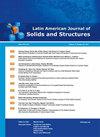Optimizing stiffness and lightweight design of composite monocoque sandwich structure for electric heavy quadricycle
IF 1.1
4区 工程技术
Q3 ENGINEERING, CIVIL
引用次数: 1
Abstract
The lightweight design of electric heavy quadricycle (L7e) vehicles has contributed to energy savings and sustainable mobility. This study proposes an optimization methodology to design a monocoque sandwich structure under operating conditions for an L7e using a finite element model via HyperWorks. Woven fiberglass fabrics and high-density PVC foam are assigned as the face and core to construct the sandwich structure, respectively. Free-size optimization based on weight minimization is applied to obtain the suitable initial thickness of face and core structures in all components. Multi-objective size optimization is then performed by minimizing both mass and material cost to determine the optimal thickness of each layer. Finally, shuffle optimization is used to modify the stacking sequence for each component to maximize structural stiffness. The results indicate that the core thickness in the passenger compartment is sufficient to maintain stiffness while maintaining the structure's lightweight. However, shuffle optimization is insignificant for the current monocoque model, as the structural stiffness is only marginally improved after the process. Additionally, this study examines the optimized models for structural stiffness and discusses suitable procedures for designing a lightweight and safe electric vehicle.电动重型四轮车单壳夹层复合结构刚度优化及轻量化设计
本文章由计算机程序翻译,如有差异,请以英文原文为准。
求助全文
约1分钟内获得全文
求助全文
来源期刊
CiteScore
2.80
自引率
8.30%
发文量
37
审稿时长
>12 weeks

 求助内容:
求助内容: 应助结果提醒方式:
应助结果提醒方式:


